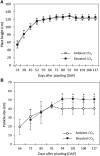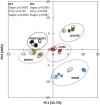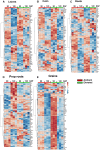Changes in Whole-Plant Metabolism during the Grain-Filling Stage in Sorghum Grown under Elevated CO2 and Drought
- PMID: 26336093
- PMCID: PMC4634081
- DOI: 10.1104/pp.15.01054
Changes in Whole-Plant Metabolism during the Grain-Filling Stage in Sorghum Grown under Elevated CO2 and Drought
Abstract
Projections indicate an elevation of the atmospheric CO2 concentration ([CO2]) concomitant with an intensification of drought for this century, increasing the challenges to food security. On the one hand, drought is a main environmental factor responsible for decreasing crop productivity and grain quality, especially when occurring during the grain-filling stage. On the other hand, elevated [CO2] is predicted to mitigate some of the negative effects of drought. Sorghum (Sorghum bicolor) is a C4 grass that has important economical and nutritional values in many parts of the world. Although the impact of elevated [CO2] and drought in photosynthesis and growth has been well documented for sorghum, the effects of the combination of these two environmental factors on plant metabolism have yet to be determined. To address this question, sorghum plants (cv BRS 330) were grown and monitored at ambient (400 µmol mol(-1)) or elevated (800 µmol mol(-1)) [CO2] for 120 d and subjected to drought during the grain-filling stage. Leaf photosynthesis, respiration, and stomatal conductance were measured at 90 and 120 d after planting, and plant organs (leaves, culm, roots, prop roots, and grains) were harvested. Finally, biochemical composition and intracellular metabolites were assessed for each organ. As expected, elevated [CO2] reduced the stomatal conductance, which preserved soil moisture and plant fitness under drought. Interestingly, the whole-plant metabolism was adjusted and protein content in grains was improved by 60% in sorghum grown under elevated [CO2].
© 2015 American Society of Plant Biologists. All Rights Reserved.
Figures







References
-
- Alexandratos N, Bruinsma J (2012) World Agriculture towards 2030/2050: The 2012 Revision. Working paper No. 12-03. Food and Agriculture Organization of the United Nations, Rome
-
- Arenque BC, Grandis A, Pocius O, De Souza AP, Buckeridge MS (2014) Responses of Senna reticulata, a legume tree from the Amazonian floodplains, to elevated atmospheric CO2 concentration and waterlogging. Trees (Berl) 28: 1021–1034
-
- Beheshti AR, Fard BB (2010) Dry matter accumulation and remobilization in grain sorghum genotypes (Sorghum bicolor L. Moench) under drought stress. Australian Journal of Crop Science 4: 185–189
-
- Blum A, Golan G, Mayer J, Sinmena B (1997) The effect of dwarfing genes on sorghum grain filling from remobilized stem reserves, under stress. Field Crops Res 52: 43–54
Publication types
MeSH terms
Substances
LinkOut - more resources
Full Text Sources
Other Literature Sources
Research Materials
Miscellaneous

